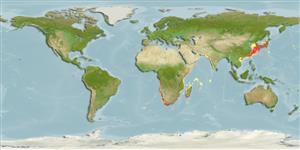Common names from other countries
Environment: milieu / climate zone / depth range / distribution range
पारिस्थितिकी
समुद्री बेनथोपिलाजिक; गहराई सीमा 20 - 400 m (Ref. 6637). Temperate
Indo-West Pacific: Mozambique and South Africa (Ref. 6637), Japan and the East China Sea. Southeast Atlantic: Cape, South Africa (Ref. 6637).
आकार / वज़न / Age
Maturity: Lm ? range ? - ? cm
Max length : 150 cm TL पुल्लिंग / अलिंग; (Ref. 559); अधिकतम प्रकाशित वज़न: 16.1 kg (Ref. 40637)
पृष्ठीय रीढ़ (सम्पूर्ण): 9 - 10; पृष्ठीय सौफट रेज़ (सम्पूर्ण): 13-14; गुदा कांटा 3; ऐनल सौफट रेज़: 12 - 13. Adults black in color; juveniles dusky silver.
Adults found in deep rocky areas; young found in shallow water. The diet consists of fishes, crustaceans and squids. Spawns from October to March.
Life cycle and mating behavior
परिपक्व अवधि | पुनरुत्पत्ति | मछलीऔ का अंडे देना | अंडे | Fecundity | लार्वा
Heemstra, P.C., 1986. Scombropidae. p. 563. In M.M. Smith and P.C. Heemstra (eds.) Smiths' sea fishes. Springer-Verlag, Berlin. (Ref. 6637)
IUCN Red List Status (Ref. 130435)
CITES (Ref. 128078)
Not Evaluated
Threat to humans
Harmless
Human uses
अधिक जानकारी
आम नामउपशब्दचपायचयपरभक्षीईकोटोकसीकोलौजीपुनरुत्पत्तिपरिपक्व अवधिमछलीऔ का अंडे देनाFecundityअंडेEgg development
संदर्भजलीयकृषिजलीयकृषि रूपरेखाखींचआनुवंशिकीElectrophoresesहैरेटिबिलटीबीमारीप्रक्रमणMass conversion
सहयोगीयोतस्वीरेStamps, Coins Misc.ध्वनिसिगुयटिरारफ्तारतैरने के प्रकारगिल क्षेत्रOtolithsदिमागदृष्टि
साधन
Special reports
Download XML
इंटरनेट स्रोत
Estimates based on models
Preferred temperature (Ref.
115969): 10.4 - 22.6, mean 18.2 (based on 218 cells).
Phylogenetic diversity index (Ref.
82804): PD
50 = 0.7500 [Uniqueness, from 0.5 = low to 2.0 = high].
Bayesian length-weight: a=0.01072 (0.00415 - 0.02764), b=3.02 (2.80 - 3.24), in cm Total Length, based on LWR estimates for this (Sub)family-body shape (Ref.
93245).
Trophic level (Ref.
69278): 4.2 ±0.63 se; based on food items.
लौटाव (Ref.
120179): निम्न, न्यूनतम जनसंख्या दुगनी होने का समय 4.5 - 14 वर्ष। (K=0.12).
Fishing Vulnerability (Ref.
59153): High to very high vulnerability (68 of 100).
